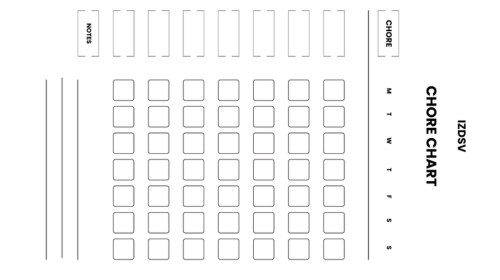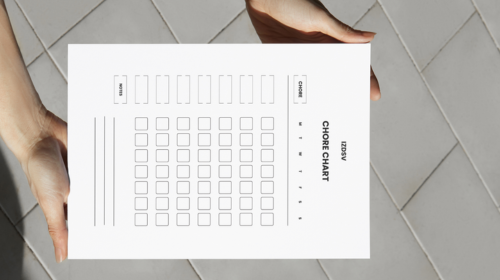How to Make a Chore Chart That Works
What is a Chore Chart and How Can It Help?
A chore chart is a visual organization tool that tracks and displays household tasks that need to be completed by family members. It helps families distribute responsibilities fairly while keeping everyone accountable for their assigned duties.
- Serves as a clear visual reminder of who needs to do what and when
- Eliminates confusion about task ownership and scheduling
- Reduces the need for parents to remind children about chores constantly
- Provides a tracking system for completed versus incomplete tasks
- Can be customized to fit your family’s specific needs and routines
- Helps establish consistent household routines and expectations
Understanding the Basics of a Chore Chart
The foundation of an effective chore chart includes clearly defined tasks, assigned responsibilities, and a tracking mechanism for completion. Basic chore charts can be as simple as a handwritten list on paper or as sophisticated as digital apps with notification systems and reward tracking.
- Contains a list of household tasks that need regular attention
- Assigns specific responsibilities to each family member
- Includes a schedule showing when each task should be completed
- Provides a method to mark or check off completed tasks
- Can be adapted for different age groups and ability levels
- May incorporate visual elements like colors, icons, or pictures for younger children
- Often includes some form of progress tracking or reward system
Benefits of Using a Family Chore Chart
Using a family chore chart creates structure and fairness while teaching important life skills to children of all ages. The benefits extend beyond just getting household tasks done, positively impacting family dynamics and individual development.
- Distributes household labor more equitably among family members
- Reduces parental workload and prevents burnout
- Decreases family conflicts about who should do what chores
- Creates predictability and routine that helps children feel secure
- Builds a sense of teamwork and family unity
- Teaches time management and organizational skills
- Prepares children for independent living as adults
- Can reduce parental nagging and associated tension
How Chore Charts Teach Responsibility to Kids
Chore charts help children develop a sense of responsibility by giving them ownership over specific tasks and allowing them to experience the natural consequences of their actions. Through completing assigned chores, children learn that their contributions matter and develop pride in being contributing members of the household.
- Establishes clear expectations for children’s contributions to the household
- Helps children understand the concept of accountability
- Builds self-confidence as children master new skills
- Develops a work ethic that transfers to school and future employment
- Teaches cause and effect relationships (work completed = rewards earned)
- Helps children understand that privileges come with responsibilities
- Provides opportunities for children to experience the satisfaction of a job well done
- Develops independence and self-sufficiency appropriate to their age
How to Create a Printable Chore Chart
Creating a printable chore chart involves planning your family’s needs and using the right tools to bring your chart to life. The process is straightforward when you follow a few key steps to ensure your chart is both functional and appealing to your family members.
- Start by listing all household chores that need to be completed regularly
- Categorize tasks by frequency (daily, weekly, monthly)
- Determine which chores are appropriate for each family member based on age and ability
- Choose a format that works for your family (calendar style, checklist, or task board)
- Select a template or create a design using word processing software, spreadsheet programs, or design tools
- Include clear instructions and visual cues if needed
- Print on sturdy paper or laminate for durability
- Place the chart in a highly visible location where everyone can access it
Choosing the Right Printable Chore Chart Template
The right chore chart template should align with your family’s organizational style and the ages of your children. Templates range from simple text-based designs to elaborate visual systems with images and interactive elements.
- Consider age-appropriate designs (picture-based for younger children, text-based for older ones)
- Look for templates that match your tracking preference (checkboxes, stickers, or magnetic pieces)
- Evaluate free templates available on parenting websites, Pinterest, or educational resource sites
- Explore paid options from Etsy or specialized family organization websites
- Check if the template allows for easy customization of chore lists and assignments
- Ensure the template has enough space for all family members and tasks
- Choose formats that can be easily updated as responsibilities change
- Select designs that complement your family’s aesthetics and motivation style
Using Canva to Design Your Own Chore Chart
Canva provides an intuitive platform for creating professional-looking chore charts with minimal design experience required. The web-based design tool offers numerous templates and customization options to create a chart that perfectly suits your family’s needs.
- Create a free Canva account to access their design tools and template library
- Search for “chore chart” in their template gallery to find starting points
- Use drag-and-drop elements to add tables, text boxes, and decorative elements
- Customize colors, fonts, and graphics to appeal to your family members
- Add photos of family members or images representing specific chores
- Incorporate your family’s branding or inside jokes to make it more personal
- Download your finished design as a PDF for printing
- Save your design to easily update it as family needs change
Customizable Options for Your Family Chore Chart
Customizing your family chore chart ensures it addresses your specific household needs and motivates each family member effectively. The right customization options can transform a basic chart into a powerful tool for family organization and responsibility building.
- Include reward systems like stickers, points, or monetary incentives
- Add space for rotating chores that change weekly among family members
- Create difficulty levels for tasks to ensure fair distribution of work
- Use color-coding to visually organize chores by person, room, or type of task
- Consider adding a difficulty rating system to balance workloads
- Include deadlines or preferred completion times for time-sensitive tasks
- Add fun elements like achievement badges or level-up systems for gamification
- Incorporate seasonal or special occasion tasks that only appear periodically
- Design special sections for weekend versus weekday responsibilities
What Are the Best Chore Chart Ideas for Kids?
The best chore charts for kids combine visual appeal, appropriate challenges, and elements of fun to keep children engaged with their responsibilities. Effective chore charts for children should be simple to understand, provide immediate visual feedback, and incorporate elements that match their developmental stage and interests.
- Magnetic chore charts with movable pieces that children can physically manipulate
- Picture-based charts for pre-readers with clear images representing each task
- Interactive charts with pull tabs, flip components, or reveal windows
- Themed charts based on children’s interests (superheroes, animals, favorite characters)
- Dry-erase charts that allow for changing responsibilities and repeated use
- Challenge-based charts that build toward rewards or privileges
- Digital apps with sound effects, animations, and achievement badges
- Growth-focused designs that visualize progress (growing plants, climbing mountains)
- Family competition boards that make chores into friendly contests
- Responsibility roadmaps that show chore mastery leading to new privileges
Age-Appropriate Chores for Different Age Groups
Assigning age-appropriate chores ensures children feel capable and successful while gradually building their skill sets and responsibility levels. The key to effective chore assignment is understanding developmental capabilities while providing the right balance of challenge and support.
Toddlers (2-3 years)
- Put toys in a toy box or designated containers
- Place dirty clothes in a hamper
- Wipe up small spills with assistance
- Help feed pets with supervision
- Put the books back on the shelves
- Match clean socks together
Preschoolers (4-5 years)
- Make bed (simple straightening)
- Set the table with non-breakable items
- Clear own dishes after meals
- Water plants with guidance
- Help unload groceries (non-breakable items)
- Dust low surfaces with socks on hands
Early Elementary (6-8 years)
- Make the bed completely
- Sort laundry by color
- Empty small trash cans
- Help prepare simple meals with supervision
- Vacuum individual rooms
- Pack own lunch with guidance
- Fold and put away simple laundry items
Older Elementary (9-11 years)
- Load and unload dishwasher
- Sweep and mop floors
- Prepare simple meals independently
- Clean bathroom sinks and counters
- Take out the trash and recycling
- Change bed sheets
- Help with grocery shopping lists
- Rake leaves or simple yard work
Middle School (12-14 years)
- Do complete laundry cycles independently
- Clean the bathroom thoroughly
- Prepare family meals occasionally
- Babysit younger siblings (short periods)
- Wash the family car
- Help with simple household repairs
- Clean refrigerator interior
High School (15-18 years)
- Meal planning and grocery shopping
- Deep cleaning tasks (carpets, windows)
- Home maintenance projects
- Complete yard work independently
- Manage own schedule for chores
- Help with family budgeting
- Mentor younger siblings in chores
- Run errands independently
Fun and Engaging Chore Chart Ideas for Kids
Creating fun and engaging chore charts transforms mundane household tasks into exciting challenges that children look forward to completing. Incorporating elements of play, competition, and imagination can dramatically increase children’s willingness to participate in household responsibilities.
- Superhero missions board where each chore represents a mission to save the household
- LEGO-based charts where children earn bricks for completed tasks to build something special
- Adventure maps where completed chores unlock new parts of a treasure hunt
- “Level up” systems inspired by video games, where harder chores earn more experience points
- Mystery chore envelopes with small surprise rewards inside
- Family challenge boards where the entire family works toward a shared goal or outing
- Seasonal themes that change throughout the year to maintain interest
- “Beat the clock” challenges for time-sensitive tasks with timers
- Storybook progression charts where completed chores advance a favorite character’s journey
- “Caught being good” systems that reward spontaneous helpful behaviors beyond assigned chores
How to Encourage Kids to Participate in Household Tasks
Encouraging children to participate willingly in household tasks requires a combination of positive reinforcement, clear expectations, and making the work meaningful. The most successful approaches involve children in the process while helping them understand the value of their contributions to the family unit.
- Involve children in creating and customizing their own chore charts
- Start with tasks that match their interests (animal lovers can care for pets, etc.)
- Set clear, realistic expectations about quality and timing
- Model enthusiasm about your own household responsibilities
- Use positive reinforcement rather than punishment-based systems
- Explain the “why” behind each task to create meaning and purpose
- Work alongside children initially until they gain confidence
- Create natural consequences rather than arbitrary punishments
- Acknowledge effort and improvement, not just perfect results
- Offer choices within appropriate boundaries (“Would you prefer to vacuum or dust?”)
- Make tasks playful with music, races against the clock, or friendly competitions
- Celebrate milestones with special recognition or family celebrations
- Connect chores to valued privileges in logical ways
- Express genuine appreciation for their contributions to the family
How to Implement a New Chore System
Implementing a new chore system requires thoughtful planning and consistent follow-through to establish lasting household routines. Success depends on clear communication, appropriate expectations, and allowing time for adjustment as family members adapt to new responsibilities.
- Start with a family meeting to explain the purpose and benefits of the new system
- Begin with fewer chores than you ultimately want and gradually increase over time
- Consider implementing the system during a less busy period, like summer break or a long weekend
- Demonstrate each chore to ensure everyone understands expectations for completion
- Create clear written or visual instructions for complex tasks
- Be consistent with follow-up and accountability during the first 3-4 weeks
- Anticipate resistance and have a plan for addressing it constructively
- Set a specific review date (perhaps after 2-3 weeks) to discuss what’s working and what needs adjustment
- Celebrate early successes to build momentum and positive associations
- Be prepared to modify the system based on what you learn during implementation
Setting Up a Daily or Weekly Chore Schedule
A well-designed chore schedule balances the family’s needs with realistic time constraints and individual capabilities. The most effective schedules account for natural family rhythms, school and work commitments, and energy levels throughout the day and week.
- Identify high-priority daily tasks that must happen regardless of circumstances
- Group similar chores together for efficiency (bathroom cleaning, kitchen tasks, outdoor work)
- Schedule time-sensitive tasks at consistent times (dishes after dinner, trash before collection day)
- Balance the workload throughout the week rather than concentrating everything on weekends
- Consider energy patterns when scheduling (morning people for early tasks, night owls for evening chores)
- Align chores with natural daily transitions (before school, after dinner, bedtime routine)
- Build in buffer time for unexpected delays or complications
- Include visual cues for days of the week for younger children
- Use time estimates to ensure reasonable workloads for each person
- Incorporate flexible blocks for seasonal or occasional tasks that arise
- Create designated “everyone helps” periods where the whole family works together
Assigning Chores Based on Family Meetings
Family meetings provide an ideal forum for collaborative chore assignment that promotes buy-in and ownership from all household members. Involving everyone in the decision-making process increases commitment to the system while teaching important negotiation and compromise skills.
- Schedule a dedicated meeting time when everyone can attend without rushing
- Start by listing all household tasks that need to be done regularly
- Discuss each family member’s strengths, preferences, and schedule constraints
- Allow children to volunteer for chores they prefer before assigning the remaining tasks
- Consider rotating certain undesirable chores so no one feels permanently stuck with them
- Use consensus-building techniques like round-robin input or preference ranking
- Establish fair workload distribution based on age, ability, and outside commitments
- Create a system for handling temporary reassignments during illness or special circumstances
- Document decisions made during the meeting in a format accessible to everyone
- Set a regular schedule for follow-up meetings to assess how the system is working
- Use thoughtful questions to guide discussion (“What chores do you feel confident doing?” “Which tasks seem unfairly distributed?”)
Keeping Track of Completed Chores
Tracking completed chores provides accountability while creating a visual record of contributions that motivates continued participation. An effective tracking system should be simple enough to maintain consistently, yet detailed enough to prevent disputes about task completion.
- Choose a centrally located tracking method visible to all family members
- Decide on a clear marking system (checkmarks, stickers, initials, or digital confirmations)
- Establish when tracking should occur (immediately after completion or at day’s end)
- Consider who will verify the quality of completed work (self-reporting vs. parent inspection)
- Implement a simple way to note partially completed tasks
- Create a system for “carried over” tasks that weren’t completed on schedule
- Use different colors or symbols to distinguish completed, verified, and missed tasks
- Include a space for notes about unusual circumstances affecting completion
- Set clear expectations about tracking honesty and consequences for misrepresentation
- Determine how long to keep records (daily reset, weekly compilation, monthly review)
- Consider using photographs of properly completed tasks as reference points for quality standards
- Integrate tracking with any reward systems or incentives your family uses
How to Make a Chore Chart That Works for Your Family?
Creating a chore chart that truly works requires understanding your unique family dynamics and designing a system that aligns with your values and practical realities. The most effective charts balance structure with flexibility while reflecting your family’s specific needs, schedule constraints, and motivational triggers.
- Assess your family’s current pain points and prioritize solving those specific challenges
- Consider each family member’s personality type and motivational style (achievement-oriented, relationship-driven, etc.)
- Evaluate your family’s schedule to identify natural times for chore completion
- Choose a format that matches your family’s communication style (visual, digital, tactile)
- Balance individual responsibilities with collaborative family tasks
- Start with a simpler system and add complexity only as needed
- Ensure the system is sustainable for the parent(s) who will oversee it
- Create accountability measures that respect everyone’s autonomy and dignity
- Design a system that can grow and evolve as children develop new capabilities
- Include methods for handling exceptions and special circumstances
- Test the system for 2-3 weeks before making significant changes
Adjusting Chores to Fit Your Family’s Needs
A successful chore system must be adaptable to your family’s changing circumstances, developmental stages, and seasonal rhythms. Regular adjustments ensure the system remains relevant and effective as your children grow and family situations evolve.
- Schedule seasonal reviews to address changing needs (school year vs. summer, sports seasons, etc.)
- Create temporary modifications for special circumstances like illness, travel, or major life events
- Adjust task assignments based on demonstrated ability and developmental progress
- Consider temporary reductions during high-stress periods like exam weeks or work deadlines
- Implement “training wheels” approaches for new or challenging tasks before full responsibility
- Create “stretch assignments” that gradually increase capability and confidence
- Develop tiered expectations for quality based on age and experience
- Balance workload across family members during different life phases
- Consider physical limitations or special needs when assigning tasks
- Implement “helper systems” where younger children assist older ones before taking on tasks independently
- Create flexible categories of responsibility rather than overly specific task lists
Monitoring and Adjusting the Chore System Over Time
Effective chore systems evolve through regular assessment and thoughtful adjustments based on family feedback and changing circumstances. The most successful families view their chore system as a living document rather than a rigid structure, making data-driven changes that improve both compliance and satisfaction.
- Schedule regular family review meetings (monthly at first, then quarterly once established)
- Watch for patterns of consistently incomplete tasks and investigate underlying causes
- Notice which elements generate enthusiasm versus resistance
- Track which system components are being maintained without reminders
- Observe if certain family members are consistently overloaded or underutilized
- Listen actively to complaints or suggestions rather than dismissing them
- Implement small adjustments rather than complete overhauls when possible
- Document successful modifications so you remember what worked
- Consider developmental milestones that might signal readiness for new responsibilities
- Watch for signs of burnout or overwhelm and respond proactively
- Assess whether your tracking system is being used consistently or becoming an additional burden
Celebrating Achievements with Your Family Chore Chart
Celebrating achievements provides motivation while reinforcing the value of contribution to the family unit. Thoughtful recognition systems create positive associations with responsibility while building children’s intrinsic motivation and sense of capability.
- Establish clear milestones worthy of special recognition (first week of completion, mastery of new skills)
- Create celebration rituals that match your family values and budget constraints
- Balance individual recognition with family-wide celebrations for collective success
- Consider non-material rewards like special privileges, activities, or quality time
- Implement visual progress trackers that show advancement toward bigger goals
- Take photos of particularly impressive completed projects to create a visual record of growth
- Share specific praise highlighting effort, improvement, and perseverance
- Create opportunities for children to showcase new skills they’ve developed
- Scale celebrations appropriately to the achievement (small recognition for daily tasks, bigger celebrations for milestones)
- Include elements of surprise and delight in your recognition system
- Encourage family members to recognize and appreciate each other’s contributions
- Connect chore completion to meaningful family values like responsibility, teamwork, and care for shared spaces
- Consider creating a “wall of fame” highlighting exceptional contributions or major improvements
- Use celebration moments as opportunities to reflect on how cooperation improves family life




